Workplace Health and Safety Risk Assessment Template Report
VerifiedAdded on 2022/12/18
|13
|2345
|62
Report
AI Summary
This report presents a comprehensive WHS (Workplace Health and Safety) risk assessment template, designed to guide organizations in identifying and managing workplace hazards. The template is divided into several parts, starting with details about the inspection and the workplace, followed by a detailed analysis of various hazard types, including biological, physical, psychosocial, ergonomic, mechanical, and environmental risks. Each hazard is described, with existing risk controls, likelihood and consequence assessments, and recommended controls to be implemented. The report also includes a section on hazard sources, risks, and controls, providing a matrix for various scenarios. Further sections detail a risk assessment matrix, a risk prioritization and control schedule, and a hierarchy of risk control. The document aims to provide a structured approach to workplace safety, enabling organizations to proactively mitigate risks and create a safer environment for employees. The assessment covers a wide array of potential dangers, from biological agents to mechanical failures, and suggests appropriate control measures based on risk levels.
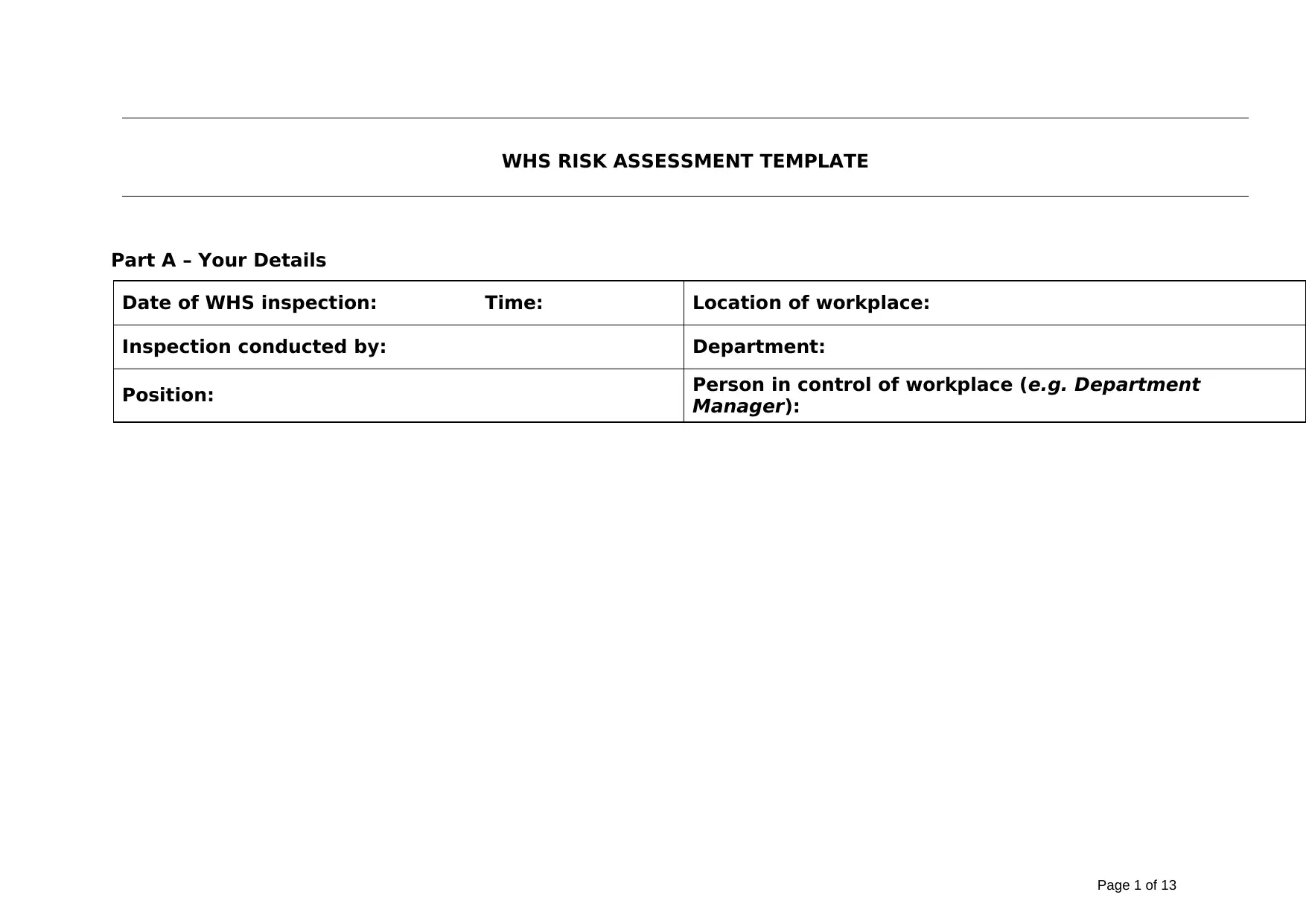
WHS RISK ASSESSMENT TEMPLATE
Part A – Your Details
Date of WHS inspection: Time: Location of workplace:
Inspection conducted by: Department:
Position: Person in control of workplace (e.g. Department
Manager):
Page 1 of 13
Part A – Your Details
Date of WHS inspection: Time: Location of workplace:
Inspection conducted by: Department:
Position: Person in control of workplace (e.g. Department
Manager):
Page 1 of 13
Paraphrase This Document
Need a fresh take? Get an instant paraphrase of this document with our AI Paraphraser
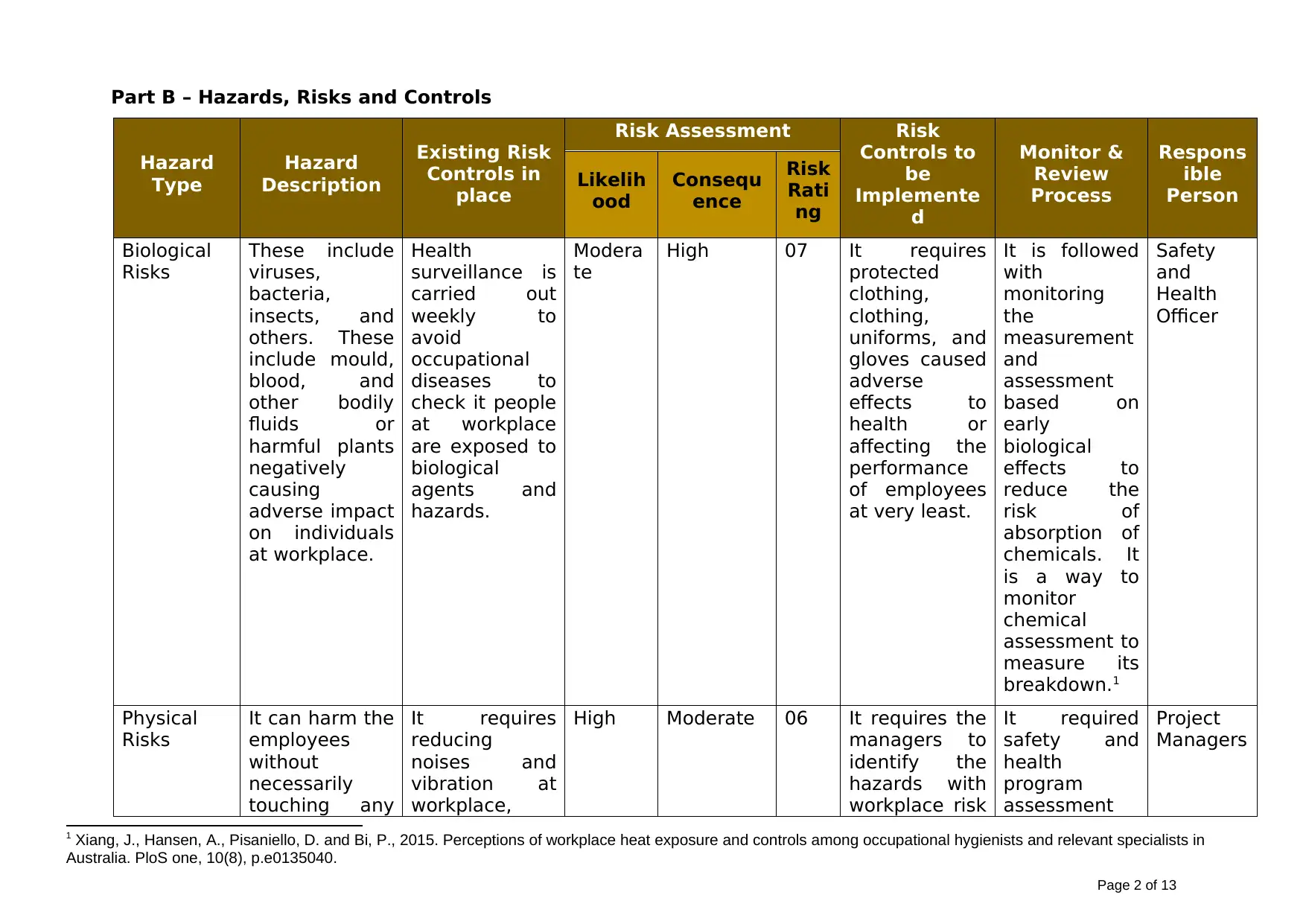
Part B – Hazards, Risks and Controls
Hazard
Type
Hazard
Description
Existing Risk
Controls in
place
Risk Assessment Risk
Controls to
be
Implemente
d
Monitor &
Review
Process
Respons
ible
Person
Likelih
ood
Consequ
ence
Risk
Rati
ng
Biological
Risks
These include
viruses,
bacteria,
insects, and
others. These
include mould,
blood, and
other bodily
fluids or
harmful plants
negatively
causing
adverse impact
on individuals
at workplace.
Health
surveillance is
carried out
weekly to
avoid
occupational
diseases to
check it people
at workplace
are exposed to
biological
agents and
hazards.
Modera
te
High 07 It requires
protected
clothing,
clothing,
uniforms, and
gloves caused
adverse
effects to
health or
affecting the
performance
of employees
at very least.
It is followed
with
monitoring
the
measurement
and
assessment
based on
early
biological
effects to
reduce the
risk of
absorption of
chemicals. It
is a way to
monitor
chemical
assessment to
measure its
breakdown.1
Safety
and
Health
Officer
Physical
Risks
It can harm the
employees
without
necessarily
touching any
It requires
reducing
noises and
vibration at
workplace,
High Moderate 06 It requires the
managers to
identify the
hazards with
workplace risk
It required
safety and
health
program
assessment
Project
Managers
1 Xiang, J., Hansen, A., Pisaniello, D. and Bi, P., 2015. Perceptions of workplace heat exposure and controls among occupational hygienists and relevant specialists in
Australia. PloS one, 10(8), p.e0135040.
Page 2 of 13
Hazard
Type
Hazard
Description
Existing Risk
Controls in
place
Risk Assessment Risk
Controls to
be
Implemente
d
Monitor &
Review
Process
Respons
ible
Person
Likelih
ood
Consequ
ence
Risk
Rati
ng
Biological
Risks
These include
viruses,
bacteria,
insects, and
others. These
include mould,
blood, and
other bodily
fluids or
harmful plants
negatively
causing
adverse impact
on individuals
at workplace.
Health
surveillance is
carried out
weekly to
avoid
occupational
diseases to
check it people
at workplace
are exposed to
biological
agents and
hazards.
Modera
te
High 07 It requires
protected
clothing,
clothing,
uniforms, and
gloves caused
adverse
effects to
health or
affecting the
performance
of employees
at very least.
It is followed
with
monitoring
the
measurement
and
assessment
based on
early
biological
effects to
reduce the
risk of
absorption of
chemicals. It
is a way to
monitor
chemical
assessment to
measure its
breakdown.1
Safety
and
Health
Officer
Physical
Risks
It can harm the
employees
without
necessarily
touching any
It requires
reducing
noises and
vibration at
workplace,
High Moderate 06 It requires the
managers to
identify the
hazards with
workplace risk
It required
safety and
health
program
assessment
Project
Managers
1 Xiang, J., Hansen, A., Pisaniello, D. and Bi, P., 2015. Perceptions of workplace heat exposure and controls among occupational hygienists and relevant specialists in
Australia. PloS one, 10(8), p.e0135040.
Page 2 of 13
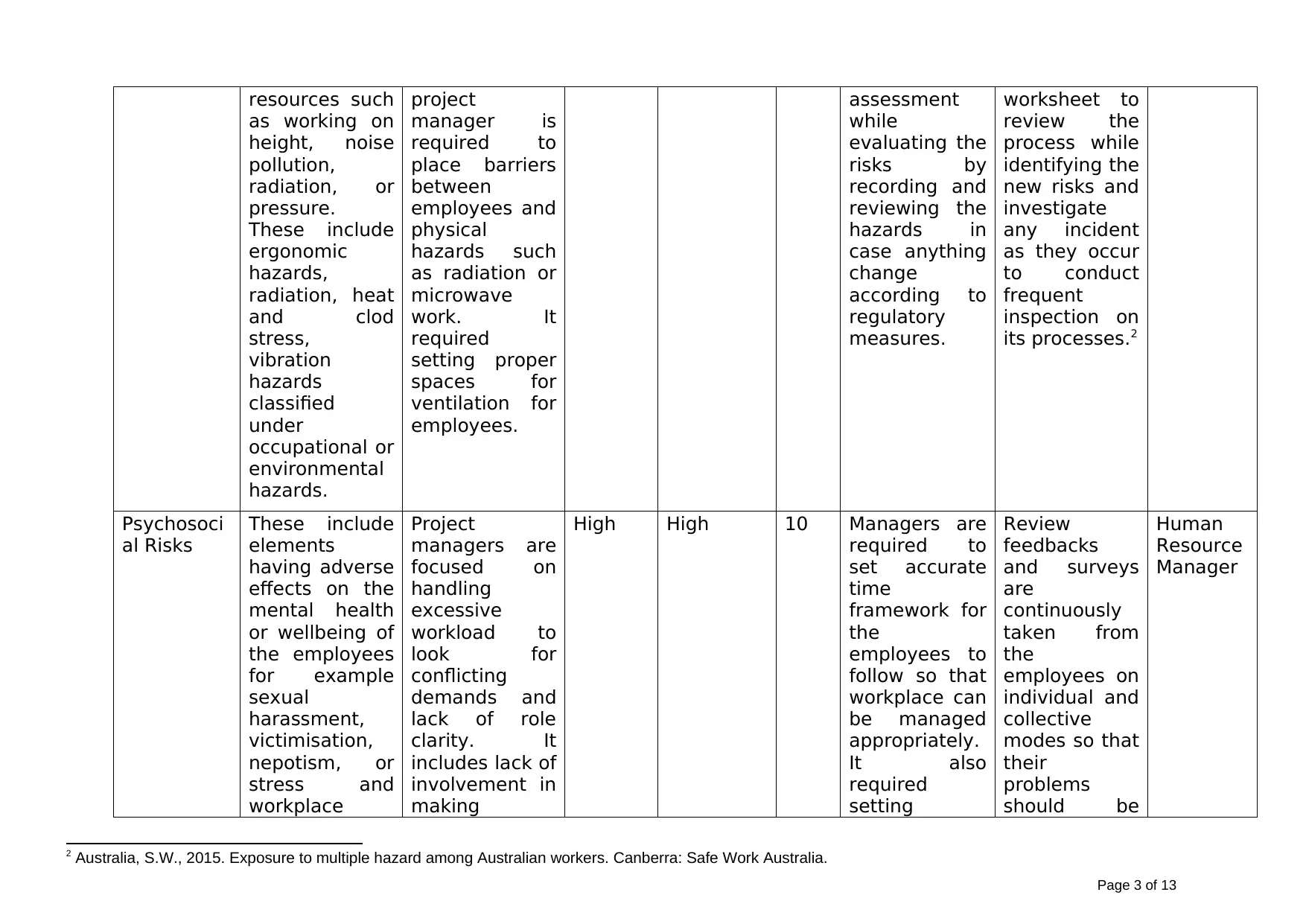
resources such
as working on
height, noise
pollution,
radiation, or
pressure.
These include
ergonomic
hazards,
radiation, heat
and clod
stress,
vibration
hazards
classified
under
occupational or
environmental
hazards.
project
manager is
required to
place barriers
between
employees and
physical
hazards such
as radiation or
microwave
work. It
required
setting proper
spaces for
ventilation for
employees.
assessment
while
evaluating the
risks by
recording and
reviewing the
hazards in
case anything
change
according to
regulatory
measures.
worksheet to
review the
process while
identifying the
new risks and
investigate
any incident
as they occur
to conduct
frequent
inspection on
its processes.2
Psychosoci
al Risks
These include
elements
having adverse
effects on the
mental health
or wellbeing of
the employees
for example
sexual
harassment,
victimisation,
nepotism, or
stress and
workplace
Project
managers are
focused on
handling
excessive
workload to
look for
conflicting
demands and
lack of role
clarity. It
includes lack of
involvement in
making
High High 10 Managers are
required to
set accurate
time
framework for
the
employees to
follow so that
workplace can
be managed
appropriately.
It also
required
setting
Review
feedbacks
and surveys
are
continuously
taken from
the
employees on
individual and
collective
modes so that
their
problems
should be
Human
Resource
Manager
2 Australia, S.W., 2015. Exposure to multiple hazard among Australian workers. Canberra: Safe Work Australia.
Page 3 of 13
as working on
height, noise
pollution,
radiation, or
pressure.
These include
ergonomic
hazards,
radiation, heat
and clod
stress,
vibration
hazards
classified
under
occupational or
environmental
hazards.
project
manager is
required to
place barriers
between
employees and
physical
hazards such
as radiation or
microwave
work. It
required
setting proper
spaces for
ventilation for
employees.
assessment
while
evaluating the
risks by
recording and
reviewing the
hazards in
case anything
change
according to
regulatory
measures.
worksheet to
review the
process while
identifying the
new risks and
investigate
any incident
as they occur
to conduct
frequent
inspection on
its processes.2
Psychosoci
al Risks
These include
elements
having adverse
effects on the
mental health
or wellbeing of
the employees
for example
sexual
harassment,
victimisation,
nepotism, or
stress and
workplace
Project
managers are
focused on
handling
excessive
workload to
look for
conflicting
demands and
lack of role
clarity. It
includes lack of
involvement in
making
High High 10 Managers are
required to
set accurate
time
framework for
the
employees to
follow so that
workplace can
be managed
appropriately.
It also
required
setting
Review
feedbacks
and surveys
are
continuously
taken from
the
employees on
individual and
collective
modes so that
their
problems
should be
Human
Resource
Manager
2 Australia, S.W., 2015. Exposure to multiple hazard among Australian workers. Canberra: Safe Work Australia.
Page 3 of 13
⊘ This is a preview!⊘
Do you want full access?
Subscribe today to unlock all pages.

Trusted by 1+ million students worldwide
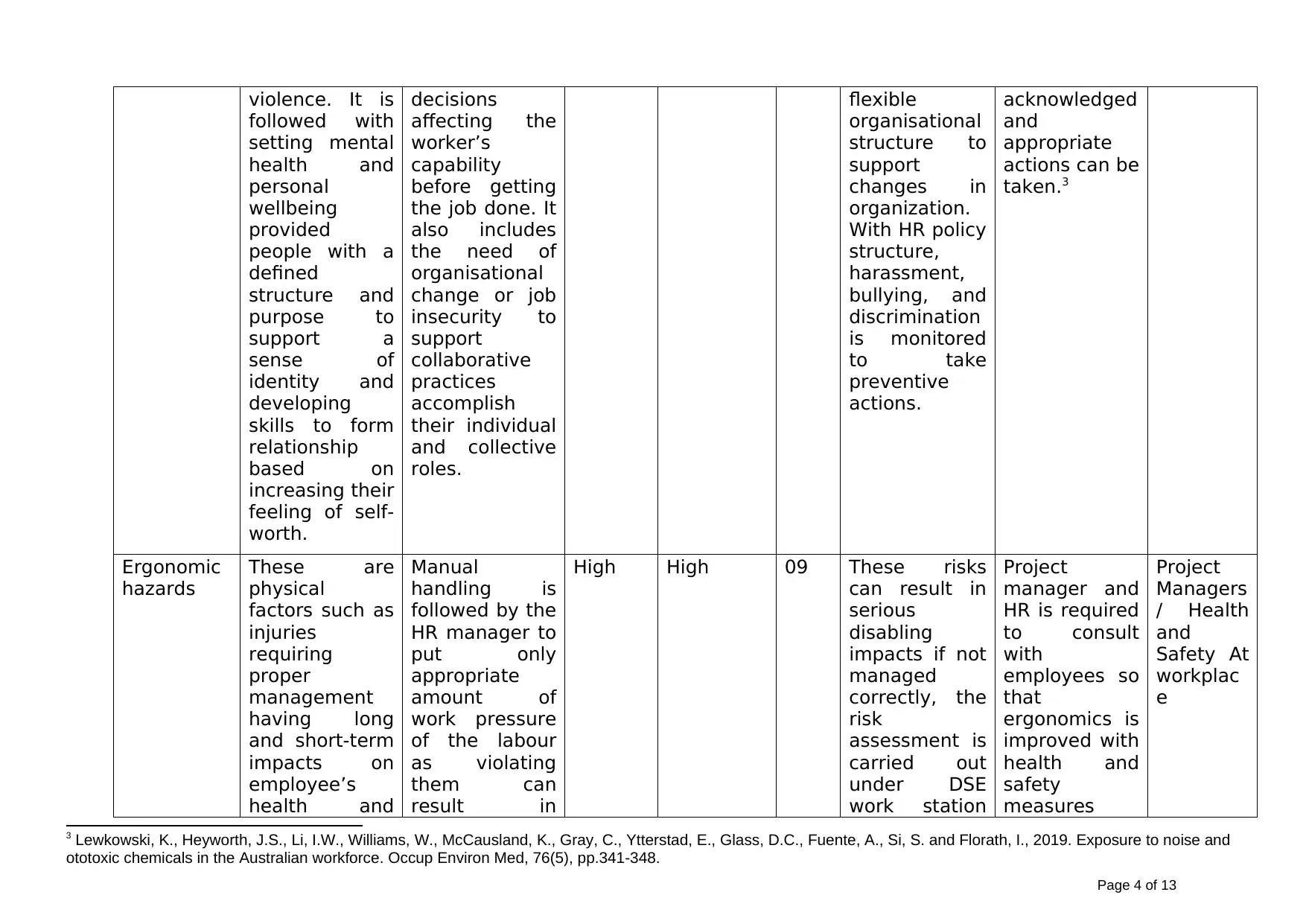
violence. It is
followed with
setting mental
health and
personal
wellbeing
provided
people with a
defined
structure and
purpose to
support a
sense of
identity and
developing
skills to form
relationship
based on
increasing their
feeling of self-
worth.
decisions
affecting the
worker’s
capability
before getting
the job done. It
also includes
the need of
organisational
change or job
insecurity to
support
collaborative
practices
accomplish
their individual
and collective
roles.
flexible
organisational
structure to
support
changes in
organization.
With HR policy
structure,
harassment,
bullying, and
discrimination
is monitored
to take
preventive
actions.
acknowledged
and
appropriate
actions can be
taken.3
Ergonomic
hazards
These are
physical
factors such as
injuries
requiring
proper
management
having long
and short-term
impacts on
employee’s
health and
Manual
handling is
followed by the
HR manager to
put only
appropriate
amount of
work pressure
of the labour
as violating
them can
result in
High High 09 These risks
can result in
serious
disabling
impacts if not
managed
correctly, the
risk
assessment is
carried out
under DSE
work station
Project
manager and
HR is required
to consult
with
employees so
that
ergonomics is
improved with
health and
safety
measures
Project
Managers
/ Health
and
Safety At
workplac
e
3 Lewkowski, K., Heyworth, J.S., Li, I.W., Williams, W., McCausland, K., Gray, C., Ytterstad, E., Glass, D.C., Fuente, A., Si, S. and Florath, I., 2019. Exposure to noise and
ototoxic chemicals in the Australian workforce. Occup Environ Med, 76(5), pp.341-348.
Page 4 of 13
followed with
setting mental
health and
personal
wellbeing
provided
people with a
defined
structure and
purpose to
support a
sense of
identity and
developing
skills to form
relationship
based on
increasing their
feeling of self-
worth.
decisions
affecting the
worker’s
capability
before getting
the job done. It
also includes
the need of
organisational
change or job
insecurity to
support
collaborative
practices
accomplish
their individual
and collective
roles.
flexible
organisational
structure to
support
changes in
organization.
With HR policy
structure,
harassment,
bullying, and
discrimination
is monitored
to take
preventive
actions.
acknowledged
and
appropriate
actions can be
taken.3
Ergonomic
hazards
These are
physical
factors such as
injuries
requiring
proper
management
having long
and short-term
impacts on
employee’s
health and
Manual
handling is
followed by the
HR manager to
put only
appropriate
amount of
work pressure
of the labour
as violating
them can
result in
High High 09 These risks
can result in
serious
disabling
impacts if not
managed
correctly, the
risk
assessment is
carried out
under DSE
work station
Project
manager and
HR is required
to consult
with
employees so
that
ergonomics is
improved with
health and
safety
measures
Project
Managers
/ Health
and
Safety At
workplac
e
3 Lewkowski, K., Heyworth, J.S., Li, I.W., Williams, W., McCausland, K., Gray, C., Ytterstad, E., Glass, D.C., Fuente, A., Si, S. and Florath, I., 2019. Exposure to noise and
ototoxic chemicals in the Australian workforce. Occup Environ Med, 76(5), pp.341-348.
Page 4 of 13
Paraphrase This Document
Need a fresh take? Get an instant paraphrase of this document with our AI Paraphraser
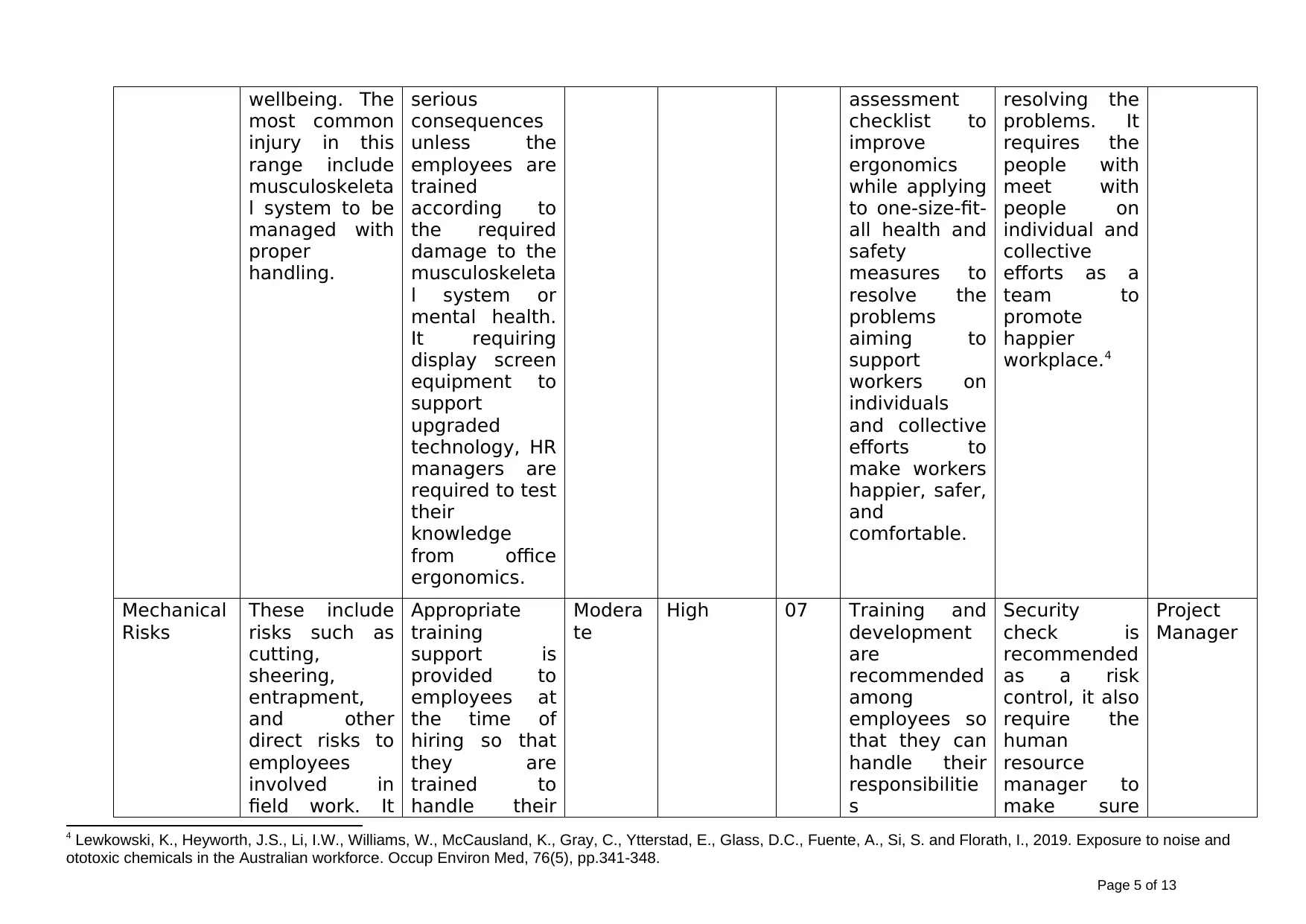
wellbeing. The
most common
injury in this
range include
musculoskeleta
l system to be
managed with
proper
handling.
serious
consequences
unless the
employees are
trained
according to
the required
damage to the
musculoskeleta
l system or
mental health.
It requiring
display screen
equipment to
support
upgraded
technology, HR
managers are
required to test
their
knowledge
from office
ergonomics.
assessment
checklist to
improve
ergonomics
while applying
to one-size-fit-
all health and
safety
measures to
resolve the
problems
aiming to
support
workers on
individuals
and collective
efforts to
make workers
happier, safer,
and
comfortable.
resolving the
problems. It
requires the
people with
meet with
people on
individual and
collective
efforts as a
team to
promote
happier
workplace.4
Mechanical
Risks
These include
risks such as
cutting,
sheering,
entrapment,
and other
direct risks to
employees
involved in
field work. It
Appropriate
training
support is
provided to
employees at
the time of
hiring so that
they are
trained to
handle their
Modera
te
High 07 Training and
development
are
recommended
among
employees so
that they can
handle their
responsibilitie
s
Security
check is
recommended
as a risk
control, it also
require the
human
resource
manager to
make sure
Project
Manager
4 Lewkowski, K., Heyworth, J.S., Li, I.W., Williams, W., McCausland, K., Gray, C., Ytterstad, E., Glass, D.C., Fuente, A., Si, S. and Florath, I., 2019. Exposure to noise and
ototoxic chemicals in the Australian workforce. Occup Environ Med, 76(5), pp.341-348.
Page 5 of 13
most common
injury in this
range include
musculoskeleta
l system to be
managed with
proper
handling.
serious
consequences
unless the
employees are
trained
according to
the required
damage to the
musculoskeleta
l system or
mental health.
It requiring
display screen
equipment to
support
upgraded
technology, HR
managers are
required to test
their
knowledge
from office
ergonomics.
assessment
checklist to
improve
ergonomics
while applying
to one-size-fit-
all health and
safety
measures to
resolve the
problems
aiming to
support
workers on
individuals
and collective
efforts to
make workers
happier, safer,
and
comfortable.
resolving the
problems. It
requires the
people with
meet with
people on
individual and
collective
efforts as a
team to
promote
happier
workplace.4
Mechanical
Risks
These include
risks such as
cutting,
sheering,
entrapment,
and other
direct risks to
employees
involved in
field work. It
Appropriate
training
support is
provided to
employees at
the time of
hiring so that
they are
trained to
handle their
Modera
te
High 07 Training and
development
are
recommended
among
employees so
that they can
handle their
responsibilitie
s
Security
check is
recommended
as a risk
control, it also
require the
human
resource
manager to
make sure
Project
Manager
4 Lewkowski, K., Heyworth, J.S., Li, I.W., Williams, W., McCausland, K., Gray, C., Ytterstad, E., Glass, D.C., Fuente, A., Si, S. and Florath, I., 2019. Exposure to noise and
ototoxic chemicals in the Australian workforce. Occup Environ Med, 76(5), pp.341-348.
Page 5 of 13
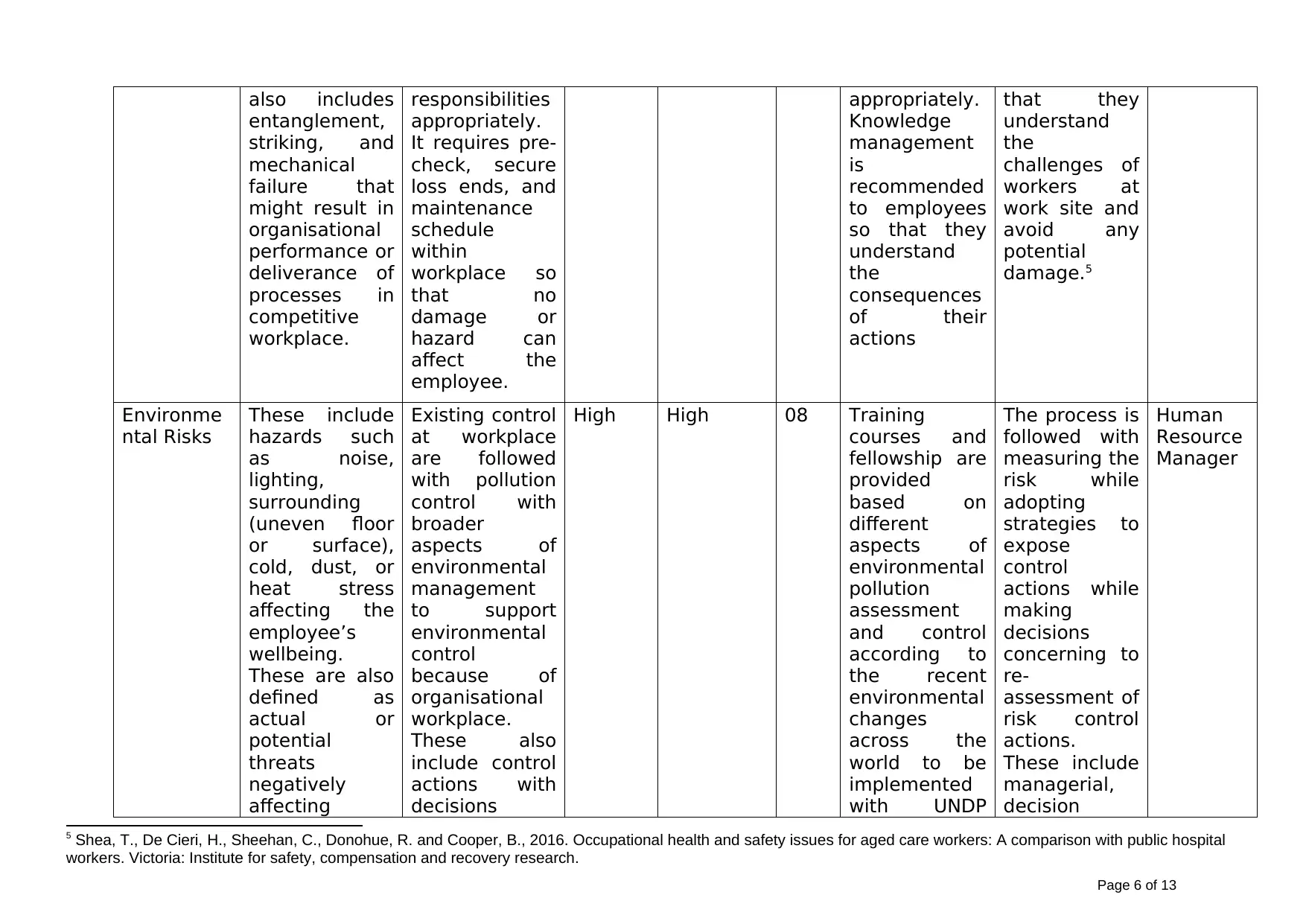
also includes
entanglement,
striking, and
mechanical
failure that
might result in
organisational
performance or
deliverance of
processes in
competitive
workplace.
responsibilities
appropriately.
It requires pre-
check, secure
loss ends, and
maintenance
schedule
within
workplace so
that no
damage or
hazard can
affect the
employee.
appropriately.
Knowledge
management
is
recommended
to employees
so that they
understand
the
consequences
of their
actions
that they
understand
the
challenges of
workers at
work site and
avoid any
potential
damage.5
Environme
ntal Risks
These include
hazards such
as noise,
lighting,
surrounding
(uneven floor
or surface),
cold, dust, or
heat stress
affecting the
employee’s
wellbeing.
These are also
defined as
actual or
potential
threats
negatively
affecting
Existing control
at workplace
are followed
with pollution
control with
broader
aspects of
environmental
management
to support
environmental
control
because of
organisational
workplace.
These also
include control
actions with
decisions
High High 08 Training
courses and
fellowship are
provided
based on
different
aspects of
environmental
pollution
assessment
and control
according to
the recent
environmental
changes
across the
world to be
implemented
with UNDP
The process is
followed with
measuring the
risk while
adopting
strategies to
expose
control
actions while
making
decisions
concerning to
re-
assessment of
risk control
actions.
These include
managerial,
decision
Human
Resource
Manager
5 Shea, T., De Cieri, H., Sheehan, C., Donohue, R. and Cooper, B., 2016. Occupational health and safety issues for aged care workers: A comparison with public hospital
workers. Victoria: Institute for safety, compensation and recovery research.
Page 6 of 13
entanglement,
striking, and
mechanical
failure that
might result in
organisational
performance or
deliverance of
processes in
competitive
workplace.
responsibilities
appropriately.
It requires pre-
check, secure
loss ends, and
maintenance
schedule
within
workplace so
that no
damage or
hazard can
affect the
employee.
appropriately.
Knowledge
management
is
recommended
to employees
so that they
understand
the
consequences
of their
actions
that they
understand
the
challenges of
workers at
work site and
avoid any
potential
damage.5
Environme
ntal Risks
These include
hazards such
as noise,
lighting,
surrounding
(uneven floor
or surface),
cold, dust, or
heat stress
affecting the
employee’s
wellbeing.
These are also
defined as
actual or
potential
threats
negatively
affecting
Existing control
at workplace
are followed
with pollution
control with
broader
aspects of
environmental
management
to support
environmental
control
because of
organisational
workplace.
These also
include control
actions with
decisions
High High 08 Training
courses and
fellowship are
provided
based on
different
aspects of
environmental
pollution
assessment
and control
according to
the recent
environmental
changes
across the
world to be
implemented
with UNDP
The process is
followed with
measuring the
risk while
adopting
strategies to
expose
control
actions while
making
decisions
concerning to
re-
assessment of
risk control
actions.
These include
managerial,
decision
Human
Resource
Manager
5 Shea, T., De Cieri, H., Sheehan, C., Donohue, R. and Cooper, B., 2016. Occupational health and safety issues for aged care workers: A comparison with public hospital
workers. Victoria: Institute for safety, compensation and recovery research.
Page 6 of 13
⊘ This is a preview!⊘
Do you want full access?
Subscribe today to unlock all pages.

Trusted by 1+ million students worldwide
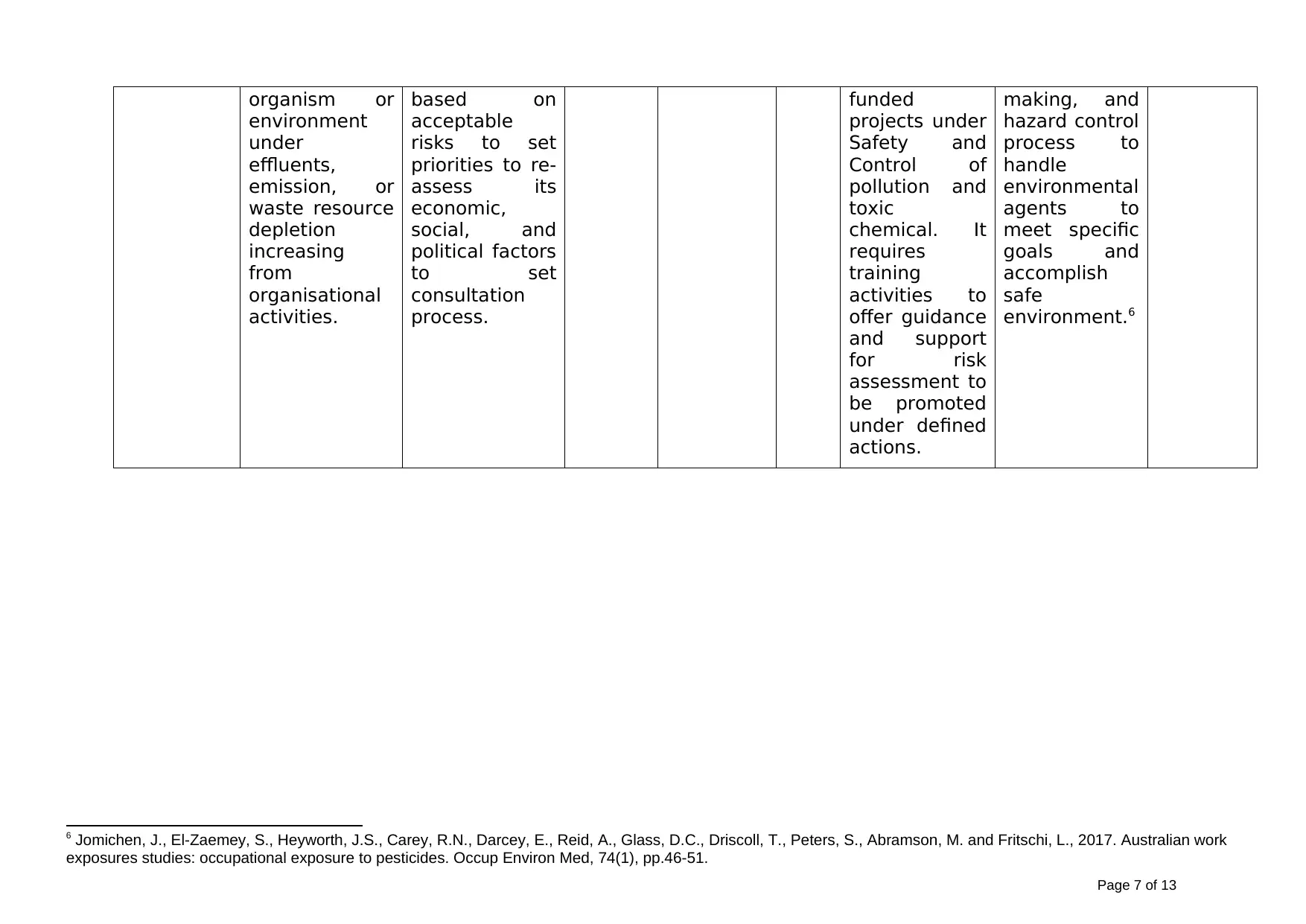
organism or
environment
under
effluents,
emission, or
waste resource
depletion
increasing
from
organisational
activities.
based on
acceptable
risks to set
priorities to re-
assess its
economic,
social, and
political factors
to set
consultation
process.
funded
projects under
Safety and
Control of
pollution and
toxic
chemical. It
requires
training
activities to
offer guidance
and support
for risk
assessment to
be promoted
under defined
actions.
making, and
hazard control
process to
handle
environmental
agents to
meet specific
goals and
accomplish
safe
environment.6
6 Jomichen, J., El-Zaemey, S., Heyworth, J.S., Carey, R.N., Darcey, E., Reid, A., Glass, D.C., Driscoll, T., Peters, S., Abramson, M. and Fritschi, L., 2017. Australian work
exposures studies: occupational exposure to pesticides. Occup Environ Med, 74(1), pp.46-51.
Page 7 of 13
environment
under
effluents,
emission, or
waste resource
depletion
increasing
from
organisational
activities.
based on
acceptable
risks to set
priorities to re-
assess its
economic,
social, and
political factors
to set
consultation
process.
funded
projects under
Safety and
Control of
pollution and
toxic
chemical. It
requires
training
activities to
offer guidance
and support
for risk
assessment to
be promoted
under defined
actions.
making, and
hazard control
process to
handle
environmental
agents to
meet specific
goals and
accomplish
safe
environment.6
6 Jomichen, J., El-Zaemey, S., Heyworth, J.S., Carey, R.N., Darcey, E., Reid, A., Glass, D.C., Driscoll, T., Peters, S., Abramson, M. and Fritschi, L., 2017. Australian work
exposures studies: occupational exposure to pesticides. Occup Environ Med, 74(1), pp.46-51.
Page 7 of 13
Paraphrase This Document
Need a fresh take? Get an instant paraphrase of this document with our AI Paraphraser
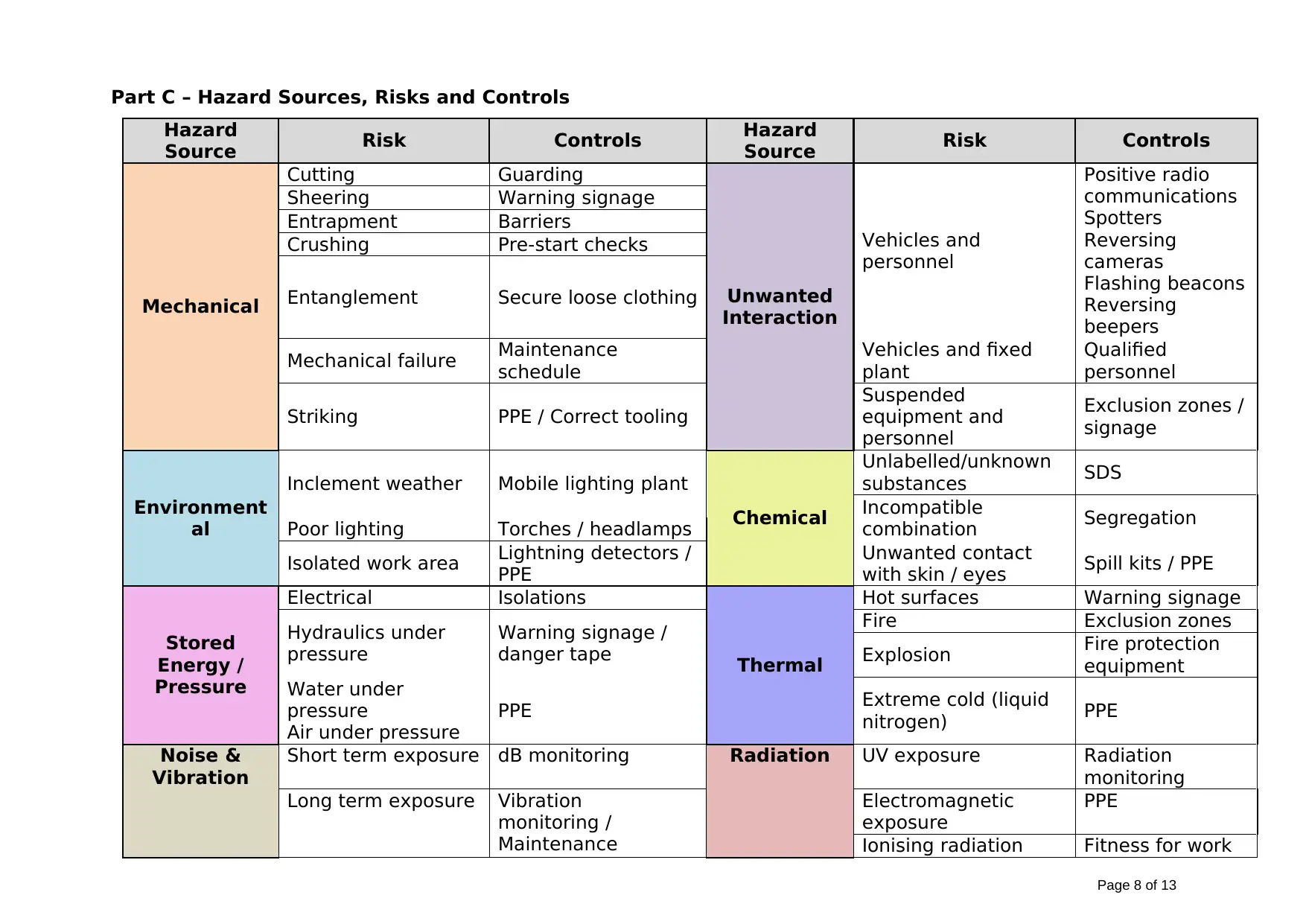
Part C – Hazard Sources, Risks and Controls
Hazard
Source Risk Controls Hazard
Source Risk Controls
Mechanical
Cutting Guarding
Unwanted
Interaction
Vehicles and
personnel
Positive radio
communications
Spotters
Reversing
cameras
Flashing beacons
Reversing
beepers
Sheering Warning signage
Entrapment Barriers
Crushing Pre-start checks
Entanglement Secure loose clothing
Mechanical failure Maintenance
schedule
Vehicles and fixed
plant
Qualified
personnel
Striking PPE / Correct tooling
Suspended
equipment and
personnel
Exclusion zones /
signage
Environment
al
Inclement weather Mobile lighting plant
Chemical
Unlabelled/unknown
substances SDS
Incompatible
combination Segregation
Poor lighting Torches / headlamps
Isolated work area Lightning detectors /
PPE
Unwanted contact
with skin / eyes Spill kits / PPE
Stored
Energy /
Pressure
Electrical Isolations
Thermal
Hot surfaces Warning signage
Hydraulics under
pressure
Warning signage /
danger tape
Fire Exclusion zones
Explosion Fire protection
equipment
Water under
pressure
Air under pressure
PPE Extreme cold (liquid
nitrogen) PPE
Noise &
Vibration
Short term exposure dB monitoring Radiation UV exposure Radiation
monitoring
Long term exposure Vibration
monitoring /
Maintenance
Electromagnetic
exposure
PPE
Ionising radiation Fitness for work
Page 8 of 13
Hazard
Source Risk Controls Hazard
Source Risk Controls
Mechanical
Cutting Guarding
Unwanted
Interaction
Vehicles and
personnel
Positive radio
communications
Spotters
Reversing
cameras
Flashing beacons
Reversing
beepers
Sheering Warning signage
Entrapment Barriers
Crushing Pre-start checks
Entanglement Secure loose clothing
Mechanical failure Maintenance
schedule
Vehicles and fixed
plant
Qualified
personnel
Striking PPE / Correct tooling
Suspended
equipment and
personnel
Exclusion zones /
signage
Environment
al
Inclement weather Mobile lighting plant
Chemical
Unlabelled/unknown
substances SDS
Incompatible
combination Segregation
Poor lighting Torches / headlamps
Isolated work area Lightning detectors /
PPE
Unwanted contact
with skin / eyes Spill kits / PPE
Stored
Energy /
Pressure
Electrical Isolations
Thermal
Hot surfaces Warning signage
Hydraulics under
pressure
Warning signage /
danger tape
Fire Exclusion zones
Explosion Fire protection
equipment
Water under
pressure
Air under pressure
PPE Extreme cold (liquid
nitrogen) PPE
Noise &
Vibration
Short term exposure dB monitoring Radiation UV exposure Radiation
monitoring
Long term exposure Vibration
monitoring /
Maintenance
Electromagnetic
exposure
PPE
Ionising radiation Fitness for work
Page 8 of 13
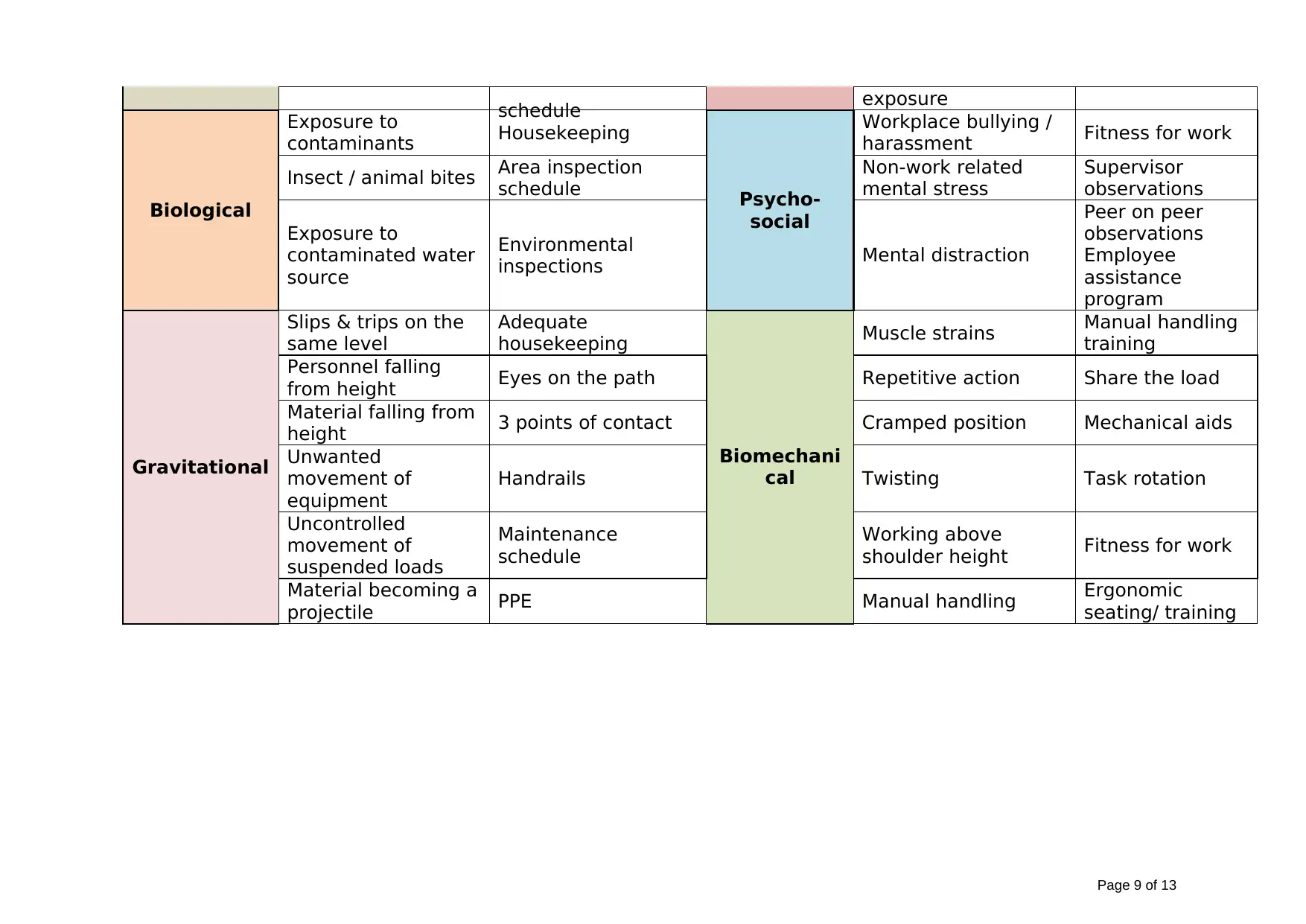
schedule exposure
Biological
Exposure to
contaminants Housekeeping
Psycho-
social
Workplace bullying /
harassment Fitness for work
Insect / animal bites Area inspection
schedule
Non-work related
mental stress
Supervisor
observations
Exposure to
contaminated water
source
Environmental
inspections Mental distraction
Peer on peer
observations
Employee
assistance
program
Gravitational
Slips & trips on the
same level
Adequate
housekeeping
Biomechani
cal
Muscle strains Manual handling
training
Personnel falling
from height Eyes on the path Repetitive action Share the load
Material falling from
height 3 points of contact Cramped position Mechanical aids
Unwanted
movement of
equipment
Handrails Twisting Task rotation
Uncontrolled
movement of
suspended loads
Maintenance
schedule
Working above
shoulder height Fitness for work
Material becoming a
projectile PPE Manual handling Ergonomic
seating/ training
Page 9 of 13
Biological
Exposure to
contaminants Housekeeping
Psycho-
social
Workplace bullying /
harassment Fitness for work
Insect / animal bites Area inspection
schedule
Non-work related
mental stress
Supervisor
observations
Exposure to
contaminated water
source
Environmental
inspections Mental distraction
Peer on peer
observations
Employee
assistance
program
Gravitational
Slips & trips on the
same level
Adequate
housekeeping
Biomechani
cal
Muscle strains Manual handling
training
Personnel falling
from height Eyes on the path Repetitive action Share the load
Material falling from
height 3 points of contact Cramped position Mechanical aids
Unwanted
movement of
equipment
Handrails Twisting Task rotation
Uncontrolled
movement of
suspended loads
Maintenance
schedule
Working above
shoulder height Fitness for work
Material becoming a
projectile PPE Manual handling Ergonomic
seating/ training
Page 9 of 13
⊘ This is a preview!⊘
Do you want full access?
Subscribe today to unlock all pages.

Trusted by 1+ million students worldwide
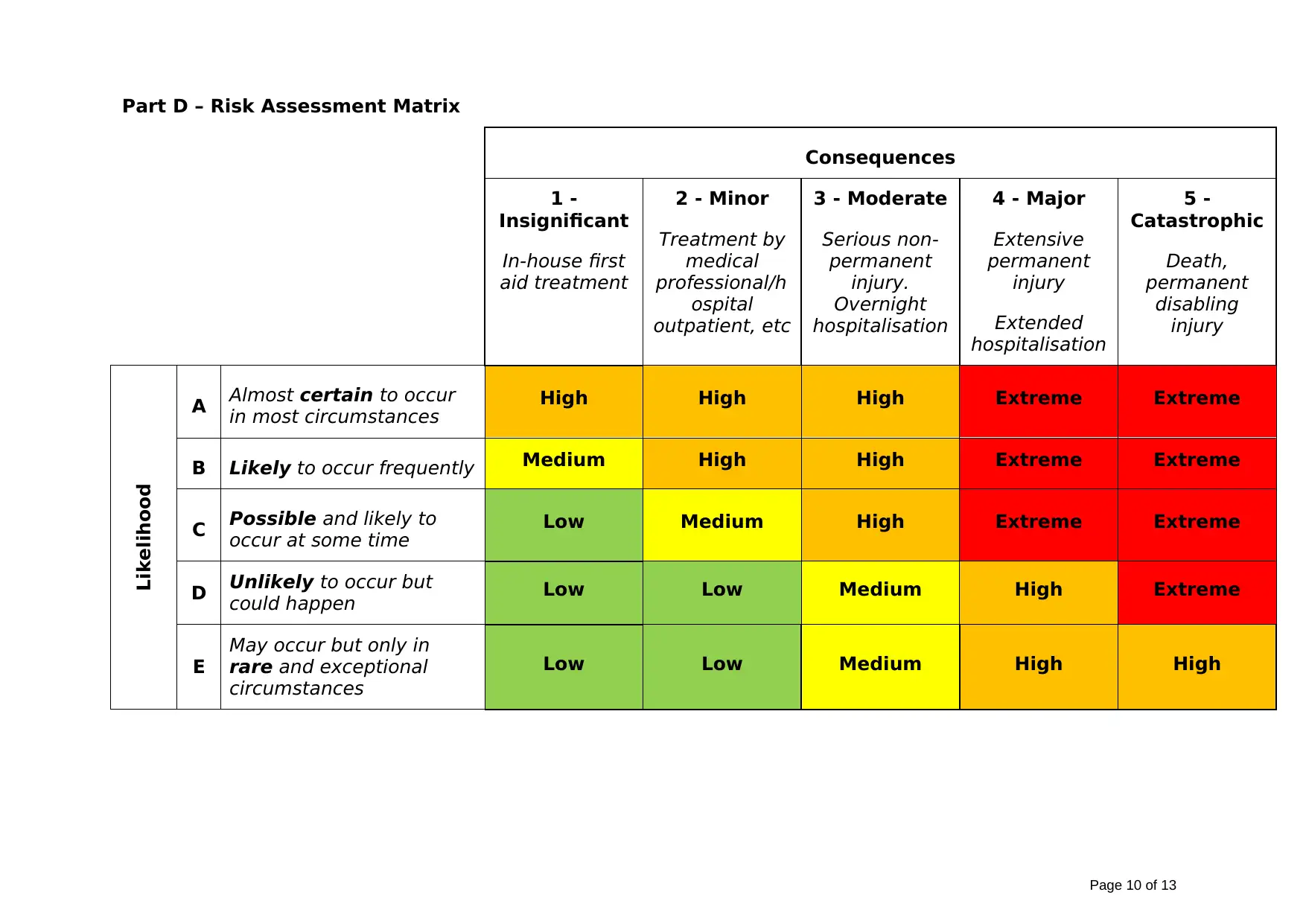
Part D – Risk Assessment Matrix
Consequences
1 -
Insignificant
In-house first
aid treatment
2 - Minor
Treatment by
medical
professional/h
ospital
outpatient, etc
3 - Moderate
Serious non-
permanent
injury.
Overnight
hospitalisation
4 - Major
Extensive
permanent
injury
Extended
hospitalisation
5 -
Catastrophic
Death,
permanent
disabling
injury
Likelihood
A Almost certain to occur
in most circumstances High High High Extreme Extreme
B Likely to occur frequently Medium High High Extreme Extreme
C Possible and likely to
occur at some time Low Medium High Extreme Extreme
D Unlikely to occur but
could happen Low Low Medium High Extreme
E
May occur but only in
rare and exceptional
circumstances
Low Low Medium High High
Page 10 of 13
Consequences
1 -
Insignificant
In-house first
aid treatment
2 - Minor
Treatment by
medical
professional/h
ospital
outpatient, etc
3 - Moderate
Serious non-
permanent
injury.
Overnight
hospitalisation
4 - Major
Extensive
permanent
injury
Extended
hospitalisation
5 -
Catastrophic
Death,
permanent
disabling
injury
Likelihood
A Almost certain to occur
in most circumstances High High High Extreme Extreme
B Likely to occur frequently Medium High High Extreme Extreme
C Possible and likely to
occur at some time Low Medium High Extreme Extreme
D Unlikely to occur but
could happen Low Low Medium High Extreme
E
May occur but only in
rare and exceptional
circumstances
Low Low Medium High High
Page 10 of 13
Paraphrase This Document
Need a fresh take? Get an instant paraphrase of this document with our AI Paraphraser
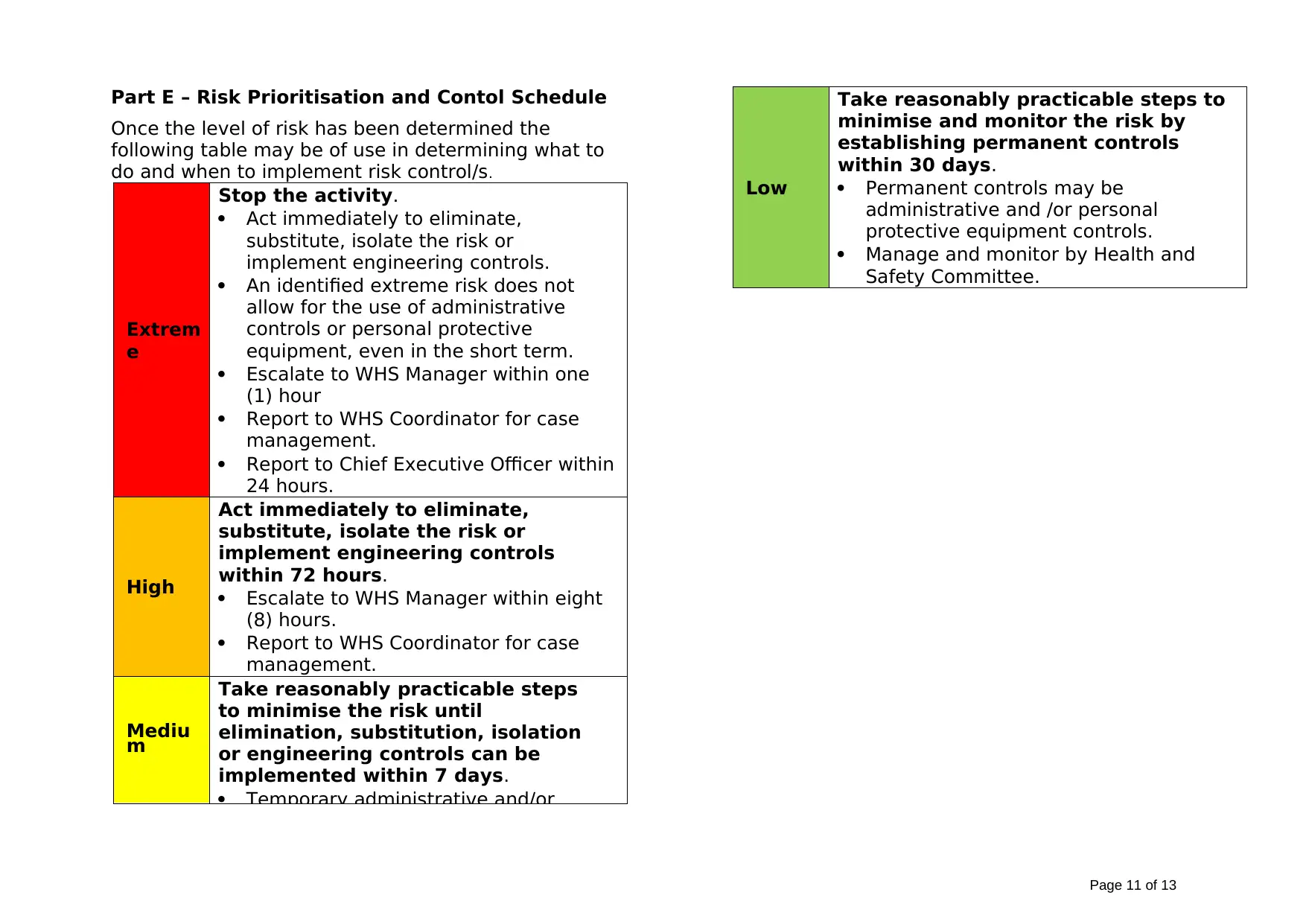
Part E – Risk Prioritisation and Contol Schedule
Once the level of risk has been determined the
following table may be of use in determining what to
do and when to implement risk control/s.
Extrem
e
Stop the activity.
Act immediately to eliminate,
substitute, isolate the risk or
implement engineering controls.
An identified extreme risk does not
allow for the use of administrative
controls or personal protective
equipment, even in the short term.
Escalate to WHS Manager within one
(1) hour
Report to WHS Coordinator for case
management.
Report to Chief Executive Officer within
24 hours.
High
Act immediately to eliminate,
substitute, isolate the risk or
implement engineering controls
within 72 hours.
Escalate to WHS Manager within eight
(8) hours.
Report to WHS Coordinator for case
management.
Mediu
m
Take reasonably practicable steps
to minimise the risk until
elimination, substitution, isolation
or engineering controls can be
implemented within 7 days.
Temporary administrative and/or
Low
Take reasonably practicable steps to
minimise and monitor the risk by
establishing permanent controls
within 30 days.
Permanent controls may be
administrative and /or personal
protective equipment controls.
Manage and monitor by Health and
Safety Committee.
Page 11 of 13
Once the level of risk has been determined the
following table may be of use in determining what to
do and when to implement risk control/s.
Extrem
e
Stop the activity.
Act immediately to eliminate,
substitute, isolate the risk or
implement engineering controls.
An identified extreme risk does not
allow for the use of administrative
controls or personal protective
equipment, even in the short term.
Escalate to WHS Manager within one
(1) hour
Report to WHS Coordinator for case
management.
Report to Chief Executive Officer within
24 hours.
High
Act immediately to eliminate,
substitute, isolate the risk or
implement engineering controls
within 72 hours.
Escalate to WHS Manager within eight
(8) hours.
Report to WHS Coordinator for case
management.
Mediu
m
Take reasonably practicable steps
to minimise the risk until
elimination, substitution, isolation
or engineering controls can be
implemented within 7 days.
Temporary administrative and/or
Low
Take reasonably practicable steps to
minimise and monitor the risk by
establishing permanent controls
within 30 days.
Permanent controls may be
administrative and /or personal
protective equipment controls.
Manage and monitor by Health and
Safety Committee.
Page 11 of 13
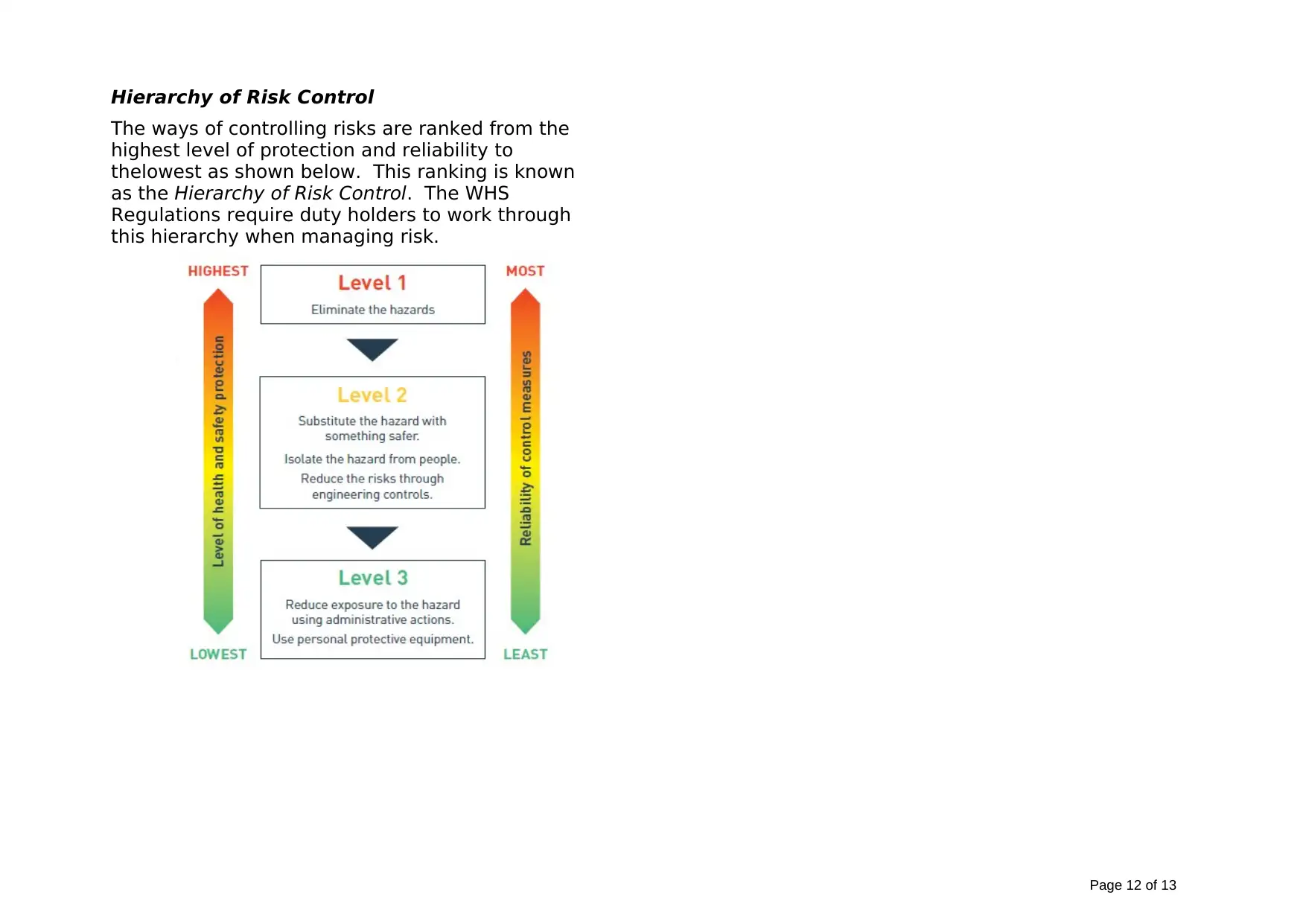
Hierarchy of Risk Control
The ways of controlling risks are ranked from the
highest level of protection and reliability to
thelowest as shown below. This ranking is known
as the Hierarchy of Risk Control. The WHS
Regulations require duty holders to work through
this hierarchy when managing risk.
Page 12 of 13
The ways of controlling risks are ranked from the
highest level of protection and reliability to
thelowest as shown below. This ranking is known
as the Hierarchy of Risk Control. The WHS
Regulations require duty holders to work through
this hierarchy when managing risk.
Page 12 of 13
⊘ This is a preview!⊘
Do you want full access?
Subscribe today to unlock all pages.

Trusted by 1+ million students worldwide
1 out of 13
Related Documents
Your All-in-One AI-Powered Toolkit for Academic Success.
+13062052269
info@desklib.com
Available 24*7 on WhatsApp / Email
![[object Object]](/_next/static/media/star-bottom.7253800d.svg)
Unlock your academic potential
Copyright © 2020–2025 A2Z Services. All Rights Reserved. Developed and managed by ZUCOL.





